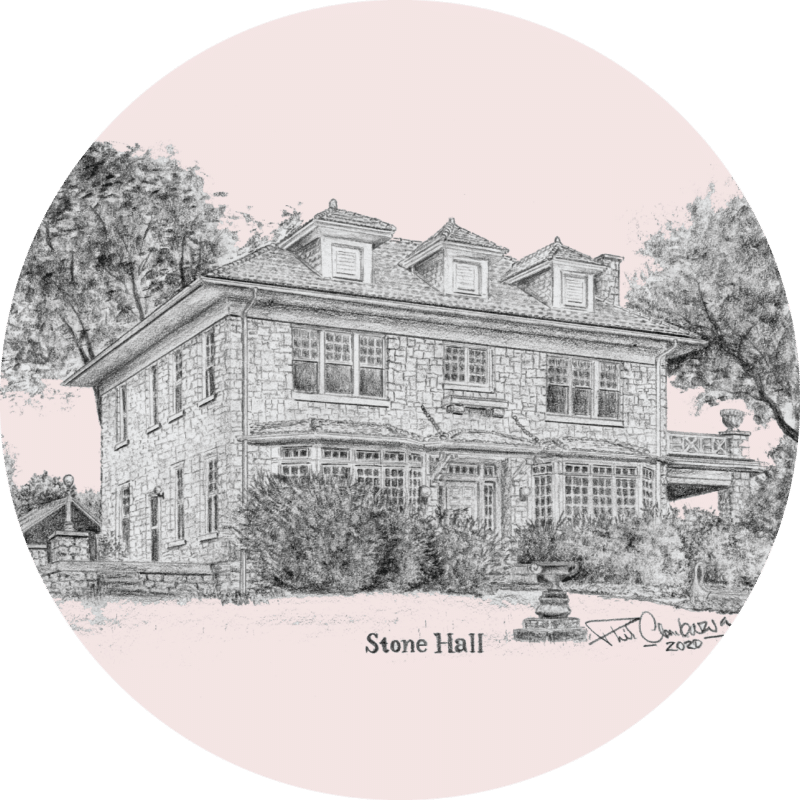Stone Hall History
A Relaxing & Unique Piece of History
Historic Stone Hall on Lebanon Road in Hermitage offers a relaxing, lovely atmosphere to rent for special events. Weddings, receptions, rehearsal dinners, parties, meetings, and celebrations can be held indoors or in the garden.
Situated on the Stones River in a beautiful setting, Stone Hall is owned by Metro Parks and available for event rentals through the Friends of Two Rivers, the property’s management partner to Metro Parks, which also handles event rentals for the Two Rivers historic mansion in Donelson.

The Story Behind Stone Hall
Stone Hall is listed on the National Register of Historic Places for its architectural significance as an example of Colonial Revival style architecture. Built in 1918, it remains an important example of architect George D. Waller’s designs and also for its integrity of setting, historic landscape features and association with twentieth century families important in Nashville history. It was built for the Cantrell family and was acquired by Metro Parks in 2007 from a Merritt family descendent of the Cantrells.
Excerpts below are from the National Register listing.


Architect, George D. Waller
Stone Hall was designed by architect George D. Waller (1883-1969).
Waller was born in Nashville and married Julia Lashley in 1911. He began practicing architecture in 1912 and his first job was supervising the building of Hume-Fogg High School in Nashville.
In 1913 he partnered with Fred W. Hinze to form Waller and Hinze. Over the years, his practice encompassed houses, commercial, and civic buildings. He designed schools in Tennessee, Kentucky, Alabama, and Georgia.
Waller was a member of the AIA and the Tennessee chapter of the AIA. At the time of his death he was a partner in George D. and Raymond Waller Architects and Engineers.
Waller is well-known in Nashville for his classical designs.
Buildings that Waller designed in Tennessee on the National Register include the Cannon County Courthouse, the East Junior High School in Nashville, the William H. and Edgar Magness Community House and Library in Warren County, and the Crichlow Grammar School and E.C. Cox Memorial Gym (demolished). Other Nashville schools he designed include Litton, Overton, Stratford, and McMurray, as well as the Davidson County Board of Education building. Waller also designed Belmont, Inglewood, Meridian Street, and Waverly Place Methodist churches. Outside of Nashville, the house called Haynes Haven in Spring Hill is a good example of Waller’s classical designs.
Building of Stone Hall
Stone Hall was built for Dempsey Weaver Cantrell (1880-1965) and Nora Johnson Cantrell (1882-1959) who married in 1907. The couple had lived on Russell Street in East Nashville’s Edgefield prior to building Stone Hall. They decided to build Stone Hall on the Stones River, away from town, after their Russell Street home narrowly missed destruction by the 1916 fire that devastated much of Edgefield.
The couple hired Nashville architect George D. Waller to design their new house and named it Stone Hall after the home of Cantrell’s English ancestors. The stone mason was Elly Hayes.
Mrs. Cantrell decided to furnish the house with Victorian-era pieces that reminded her of her happy childhood and their home on Russell; thus the Colonial Revival structure featured a great deal of Victorian-era furnishings, including original light fixtures from the Russell Street house. (Angie Cantrell Merritt Donelson recalled in 1977 that the Russell Street house was demolished in the 1960s “to make way for the expressway.”)
They completed Stone Hall in 1918 on land they were given by Nora’s father, J.J. Johnson, and named it after their ancestors in England.
The property was eventually inherited by their only child, Angie (Cantrell Merritt Donelson Ezell), who returned there to live from 1963 until the 1970s.
By 2001 it was by inherited her three grandchildren, the children of Angie’s son, Judge Gilbert Merritt Jr.
It was lived in by the granddaughter Louise Merritt for a few years, then by her brother Stroud, and remained in the family until its purchase from Stroud Merritt in 2007 by Metro Parks.
Mrs. Cantrell
Mrs. Cantrell was born Nora Johnson in Wilson County and moved to Davidson County as a child. According to her obituary “She was a poet and authoress and had been poet laureate of the Tennessee Federated Women’s club.”
She had been named Poet Laureate of the Tennessee Federation of Women’s Clubs in 1939, and was featured on the cover of the May 1948 issue of the Tennessee Parent-Teacher Magazine.
For many years, Nora Johnson Cantrell donated funds for a student poetry contest that was sponsored by the Tennessee Federation of Women’s Clubs. She is noted as the editor of a book of verses by high school students, Lyrical Tennessee: An Anthology of verse by the Youth of Tennessee. This volume includes first, second, third place winners, and honorable mentions. After her death, Mr. Cantrell established the Nora Johnson Cantrell Student Poetry Trust. The trust was formed on February 2, 1961, “when thirty-six shares of Standard Oil stock were donated to the TFWC to endow the Fund; coupons are clipped each year for the Poetry Award Fund.”
Eversong Cabin
Mrs. Cantrell would write her poetry in the cabin she called Eversong. According to local historian Leona Aiken, Mr. and Mrs. Cantrell moved the log building to the property in the 1930s, from Wilson County, where both families were from; Mrs. Cantrell felt that in this quiet natural beauty place ‘she ever had a song in her heart….’
To this place she retired to commune with God, Nature, and the Muse.” In 1950 she published Buoyant Wings, a book of her poetry. Poems in the book include The Vision, Humility, Buddie, Even I, Trophies, Dogs, Autumn, Daffodils, Fate, and the title poem Buoyant Wings
Rapturously my spirit soars
Beyond the reach of human kind
Unleashed and free of earthly doors.
I seek the realm of the Sublime.
Ah, Peter of his chain was free
At voice of Him who calls to me
Artists and friends of the family also stayed in the log building. Mrs. Cantrell served as a charter member of the Lebanon Road Garden Club (founded 1929) and as a Chaplain in both the Tennessee Press and Authors Club, and the Nashville Press and Authors Club.
Mr. Cantrell
Dempsey Weaver Cantrell founded the Southern Woodenware Company in 1903, a large wholesale paper goods company, with headquarters on Second Avenue North near Broadway. He sold the company in 1946 to his son-in-law, Gilbert Merritt, Sr.; following Merritt’s death in 1955, Cantrell’s daughter Angie Cantrell Merritt assumed the directorship. After Cantrell’s death in 1965, Mrs. Merritt sold the company out of the family.
Among his many civic activities, Cantrell served on the Davidson County School Board (president 1926-1932), was a member of the Rotary Club, a member of the Nashville Chamber of Commerce, and was a Mason. Mr. Cantrell was also a member of the founding Board of Directors of the Bank of Donelson, established in 1936, along with R. D. Stanford. (The Bank of Donelson was sold to Commerce Union Bank in 1948.)
Both Cantrells were also very involved in a variety of Donelson community organizations, and were heavily involved in the Donelson First Baptist Church, providing the organ and a Missionary Trust Fund for the church.
Before having this house built, the Cantrells lived in East Nashville’s Edgefield neighborhood on Russell Street. Following the Great Fire in East Nashville in 1916 that “just missed” the Cantrell’s Russell Street home, they decided to build a suburban estate on land owned by Mrs. Cantrell’s parents in the Donelson area. Mrs. Cantrell’s father lived with the couple until his death circa 1930.
The Cantrell’s daughter, Angie Cantrell Merritt, recalled in a 1977 interview that her parents “moved into Nashville for several years, but were happier to come back to the country and built this house [Stone Hall] on land my mother’s father, J.J. Johnson gave them.”
Daughter, Angie Fields Cantrell
The Cantrells had one child, a daughter, named Angie Fields, after her grandmother. Angie Fields Cantrell married Gilbert Stroud Merritt in December 1934 at Stone Hall and they had one son, Gilbert Stroud Merritt, Jr., born in 1936.
Following her husband’s death in 1955, Angie Cantrell Merritt remarried, to John Donelson VII, and they moved to Stone Hall in 1964 (she later married an Ezell).
The Garden
Angie Merritt Donelson recalled that she brought shrubs, flowers, plants, statuary, and garden furniture with her to Stone Hall, and with the help of Geddes Douglas (1902-1993) of Nashville, planted a “lovely garden” off the west terrace of the house, near her mother’s “Flower Garden” that lay northwest of the house. Douglas, a chemist and businessman, was the owner of the Douglas Geddes Garden Center in Nashville. He was involved with the Tennessee Nurserymen’s Association, Southern Nursery Association, and was a Nashville television commentator. Geddes was known for his irises and the American Iris Society has awarded a Cook-Douglas medal since 1959. A small plaque to the west of the house in a planted area reads:
Oh, I live in a house at the top of a hill,
Where the clouds go drifting by.
And each lovely flower in the garden there,
Lifts its smiling face to the sky.
Although the formal gardens no longer exist as planted, some plantings still survive. By 2001, Louise Merritt, a granddaughter of Gilbert and Angie Merritt, lived at Stone Hall.
Stone Hall’s Place in Community
Stone Hall is located in an area east of Nashville, the Donelson and Hermitage neighborhoods, where early nineteenth century expansion consisted of properties such as The Hermitage, Belair and Clover Bottom Mansion. Robert and Arthur Stanford bought the Clover Bottom property in 1918. Arthur was a dairy farmer at Clover Bottom and his brother Robert built new residential developments in the emergent suburban area.
Bluefields, Stinson Circle, and Fairview Drive were built as middle class suburban housing beginning in the teens through the mid-twentieth century. In addition, along with his architect father-in-law William Meredith, Stanford built larger end houses known locally as “Millionaires Row” close to Stone Hall. Most of these residences have been lost to more recent commercial developments.
Stone Hall is generally considered the best remaining example of early twentieth century classical design in the Donelson and Hermitage neighborhoods.
Stone Hall Protected for Public Use
In 2006-2007, the Metropolitan Government of Nashville and Davidson County and Greenways for Nashville (with grants from the Memorial Foundation and the Tennessee Department of Environment and Conservation and cooperation from the owner, Gilbert Stroud Merritt, III) acquired Stone Hall, Eversong, the associated outbuildings, and surrounding acreage for use as a park and trailhead for the greenway system, venue for public events and rentals for weddings and receptions, and eventual park nature and cultural programs.
